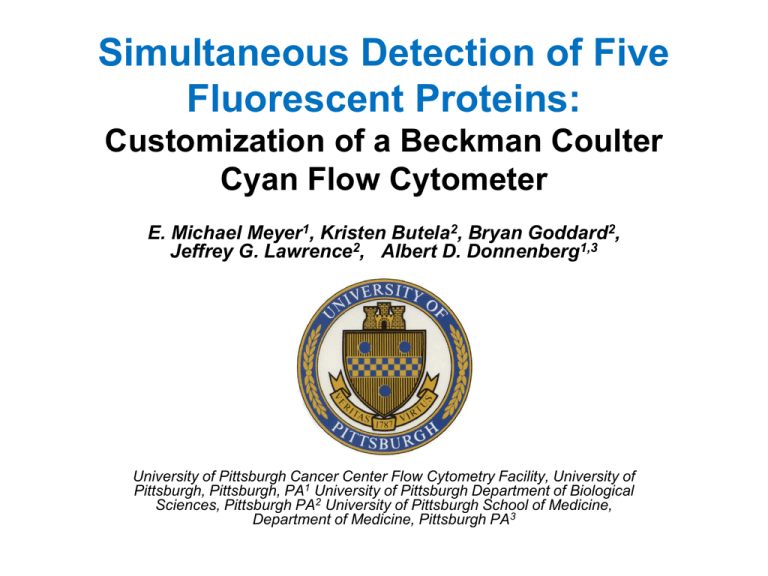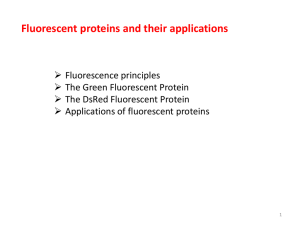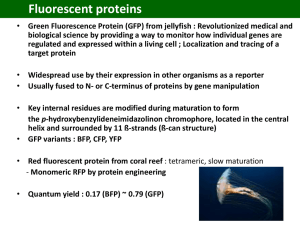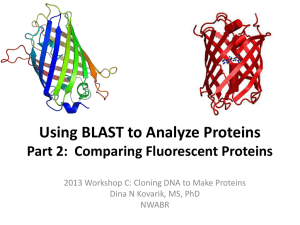UPitt Customization Cyan
advertisement

Simultaneous Detection of Five Fluorescent Proteins: Customization of a Beckman Coulter Cyan Flow Cytometer E. Michael Meyer1, Kristen Butela2, Bryan Goddard2, Jeffrey G. Lawrence2, Albert D. Donnenberg1,3 University of Pittsburgh Cancer Center Flow Cytometry Facility, University of Pittsburgh, Pittsburgh, PA1 University of Pittsburgh Department of Biological Sciences, Pittsburgh PA2 University of Pittsburgh School of Medicine, Department of Medicine, Pittsburgh PA3 Abstract Green Fluorescent Protein (GFP) tagged vectors have been of great utility for selection and analysis of cells on the basis of expression of specific genes. The development of GFP derivatives and other fluorescent proteins now offers a palate of markers with varying degrees of spectral separation. Although flow cytometric analysis and sorting of cells expressing GFP is widespread, the use of multiple fluorescent proteins (FPs) has lagged behind. Multi-laser flow cytometers initially evolved in the direction of detecting multiple fluorochrome-conjugated antibodies. Detection of multiple fluorescent proteins requires a reconfiguration of optical filters to match their unique spectral properties. The Beckman Coulter Cyan was among the first cytometers equipped with 405nm, 488nm, and 643nm solid state lasers. The standard filter sets are configured for detection of near u.v. excitable dyes (Cascade, Pacific), FITC, PE and APC, their tandems. Although this standard configuration is not well suited for the analysis of multiple FPs, the modular design of the CyAn filter block is well suited to custom configuration. . Abstract In order to implement experiments involving the fluorescent barcoding of live Salmonella typhimurium LT2, we reconfigured the filter set on our CyAn for detection of five fluorescent proteins (mKalama, CFP, GFP, YFP, and dsRed). Filters were chosen in consultation with Brian Manning (Chroma Technology, Bellows Falls, VT) based on the emission spectra of the FPs. mKalama and CFP are excited by the 405 nm laser. Emissions are resolved with 440/20 and 470/20 BP filter respectively, separated with a 455 LP dichroic. GFP, YFP and dsRed are excited by the 488nm laser. Emissions are resolved with 510/20, 550/30 and 610/20 BP filters and separated by 530 and 575 LP filters. Bacterial events expressing single FPs were triggered on log forward scatter. Initial PMT voltage settings were determined empirically and optimized using an algorithm described in a separate abstract submitted to this meeting (A. D. Donnenberg). The algorithm determines a set of PMT voltages which minimize spectral overlap within the limits of user determined constraints on maximal and minimal gain. This combined approach of optimizing optical filters and PMT settings permits the resolution of organisms expressing 31 distinct combinations of FPs. The Project The Lawrence Lab proposed a project to examine the bacterial spectrum that presents in the lower intestine of the common Anole. They wished to pre-label different strains of Salmonella typhimurium with fluorescent proteins (FPs) and observe the distribution various strains. They wished to utilize several FPs and wanted to know the limitations of the Cyan flow cytometer. Could we visualize the bacteria and how many different FPs could we see at one time? Can We Do This Experiment? Earlier the previous year, we had completed another project where a researcher wished to detect GFP infected Mycobacterium tuberculosis. We knew from experience that the Cyan could detect small particles and do so in the context of a GFP analysis. Electron Micrograph by Christophe Demay from the Institut Pasteur de Guadeloupe Piuri M, Jacobs WR Jr, Hatfull GF (2009) Fluoromycobacteriophages for Rapid, Specific, and Sensitive Antibiotic Susceptibility Testing of Mycobacterium tuberculosis. PLoS ONE 4(3): e4870. doi:10.1371/journal.pone.0004870 Common Fluorescent Proteins Hawley, Hawley, and Telford have provided comprehensive guidelines for the analysis of multiple Fluorescent Proteins. In 2001 several invaluable references describe the simultaneous analysis of 4 FPs. Hawley, T. S., Herbert, D. J., Eaker, S. S., and Hawley, R. G. 2004. Multiparameterfl ow cytometry of fluorescent protein reporters. Flow Cytometry Protocols, Second Edition, Methods Mol. Biol. 263. T.S. Hawley and R.G. Hawley, eds. (Humana Press Inc., Totowa, NJ) 219-238. Pruitt, S. C., Mielnicki, L. M., and Stewart, C. C. 2004. Analysis of fluorescent protein expressing cells by flow cytometry. Flow Cytometry Protocols, Second Edition,Methods Mol. Biol. 263. T.S. Hawley and R.G. Hawley, eds. (Humana Press Inc., Totowa, NJ) 239-258. Hawley, T.S. ,Telford, W.G., Ramezani, A., and Hawley, R.G. 2001. Four-Color Flow Cytometric Detection of Retrovirally Expressed Red, Yellow, Green, and Cyan Fluorescent Proteins Biotechniques 30:1028-1034. Hawley, T.S. ,Telford, W.G., and Hawley, R.G. 2001. “Rainbow” Reporters for Multispectral Marking and Lineage Analysis of Hematopoietic Stem Cells. Stem Cells 19:118-124. Common Fluorescent Proteins The excitation and emission spectra of five FPs are shown in this poster from Chroma Technology. Through the implementation of “tight” band pass and appropriate dichroic filters , it seemed possible that we could increase the number of available fluorescent proteins that could be used at one time. Blue Fluorescent Protein would prove to be inadequate and until the development of BFP variants the assay would be limited to four. Improvement of Blue Fluorescent Proteins (BFPs) Improvement of BFPs “Despite the fact that it has neither the highest intrinsic brightness nor the best photostability of the new variants mKalama1 is the brightest blue FP when expressed in bacteria This result suggests that the intensive directed evolution effort that produced mKalama1 selected for efficient protein folding and chromophore maturation in bacteria in addition to high intrinsic brightness.” The development of mKalama as a robust 405nm excitable Fluorescent Protein is a welcome addition. It allows for the expansion of a well characterized 4 color panel into the lower wavelength domain. 5 colors are now available without the costly addition of a green of yellow laser. Cyan Native Optical Configuration The Beckman Coulter Cyan is designed to detect 9 colors. Typical configuration allows for the detection of 2 colors excited by the 405nm laser, 5 colors excited by the 488nm laser and 2 colors excited by the 640nm laser. For the development of this assay, the cyan would be limited to the original 3 laser. We could not add a green or yellow laser. Optical filters (dichroics and bandpass filters) are mounted in easily accessible filter holders. New filters can easily be mounted into spare holders and replaced in a matter of seconds. Cyan Modified Optical Configuration 405 nm excitation of mKalama and CFP 488nm excitation of GFP, YFP and dsRed mKalama, CFP, GFP, YFP, and dsRed were studied and spectral characteristics were taken into account. Consultation with Chroma Technology made it easy to select new optical filters. Utilizing the existing 405nm and 488nm laser lines, replacing 5 bandpass filters and 3 dichroic filter now allows for the simultaneous detection of all 5 FPs while at the same time minimizing spectral overlap. Optical Filter Comparison Original Filters Bandpass Filter 450/50 530/30 530/40 575/35 613/20 Pacific Blue Cascade Yellow FITC PE ECD Dichroic Filter 485 LP 545 LP 595 LP Modifided Filters Bandpass Filter 420/20 470/20 510/20 550/30 610/20 mKalama CFP GFP YFP dsRed express Dichroic Filter 455 LP 530 LP 575 LP Individual Fluorescent Protein Profiles PMT Voltage Sweep Scatter Plot Scatter Plot Scatter Plot 2 2 4 LMFI 3 mKalama 1 CFP 0 -1 300 2 dsRed LMFI LMFI 1 0 500 700 -1 300 900 VOLTS Scatter Plot 500 700 900 600 800 VOLTS Scatter Plot 3 3 2 2 600 800 VOLTS YFP LMFI 0 400 LMFI 1 1 1 GFP 1000 0 -1 200 0 400 600 VOLTS 800 -1 200 400 VOLTS The first step in understanding how voltage changes effect spillover coefficients (compensation) is to observe the change of measured Mean Fluorescence Intensity (MFI) of a particular FP as voltage changes. Individual FPs are run at various voltages (in this case, 20 volt increments) Regression analysis of results are shown above. Spillover Calculator PBMC Min Capture 3rd Peak 3rd Peak PBMC MIN VOLT MAX VOLT Min target Max target ORIG %OFF AXIS VOLTS VOLTS Mkalama 400 900 Mkalama Mkalama 822 CFP 400 900 CFP CFP GFP 400 900 GFP GFP YFP 400 900 YFP DSRed 400 900 DSRed INTO THAT Regression Coefficients ADDED NEW VOLTS MACRO B C 886 AMkalama 0.01 -4E-06 592 -2 590 BCFP 0.01 -4E-06 470 10 480 CGFP 0.01 -7E-06 YFP 508 5 513 DYFP 0.01 -7E-06 DSRed 530 -13 517 EDSRed 0.01 -4E-06 PREDICTED SPILLOVER MATRIX THIS THIS GFP Mkalama Mkalama 2.70% CFP CFP GFP GFP 0.34% 2.56% YFP YFP 0.24% 1.89% ##### DSRed DSRed 0.20% 1.62% ##### 1.71% 1.37% YFP DSRed INTO THAT Mkalama CFP GFP 0.19% 0.39% Mkalama 0.17% 0.30% CFP 11.70% 1.05% GFP 0.12% 3.65% 8.98% YFP 0.07% 2.32% ##### DSRed 0.04% 1.24% ##### 8.65% ##### 4494 64 OBSERVED SPILLOVER MATRIX MkalamaCFP PREVIOU S SS INCREMENT ##### YFP 4.82% 0.96% DSRed 0.62% 2.03% 0.14% 0.39% 40.83% 4.68% 1 1.95% ##### 14.04% GFP and YFP emission have a great deal of spectral overlap. Optimal PMT gain settings minimize spectral compensation. Having the ability to predict the relationship between voltage change and MFI change, one can observe the relative effect of voltage change on spectral spillover. Spillover is minimized when detector voltages are “balanced” In search of Optimal PMT Gain Albert D Donnenberg PhD CYTO 2010 Parrallel session 4-19 8:30 am Wednesday May 12 First Run Results First Run Results Screen capture from the first run with modified filter set Conclusion: It is possible to resolve five fluorescent proteins using only conventional blue and red lasers. Spectrum and filters











